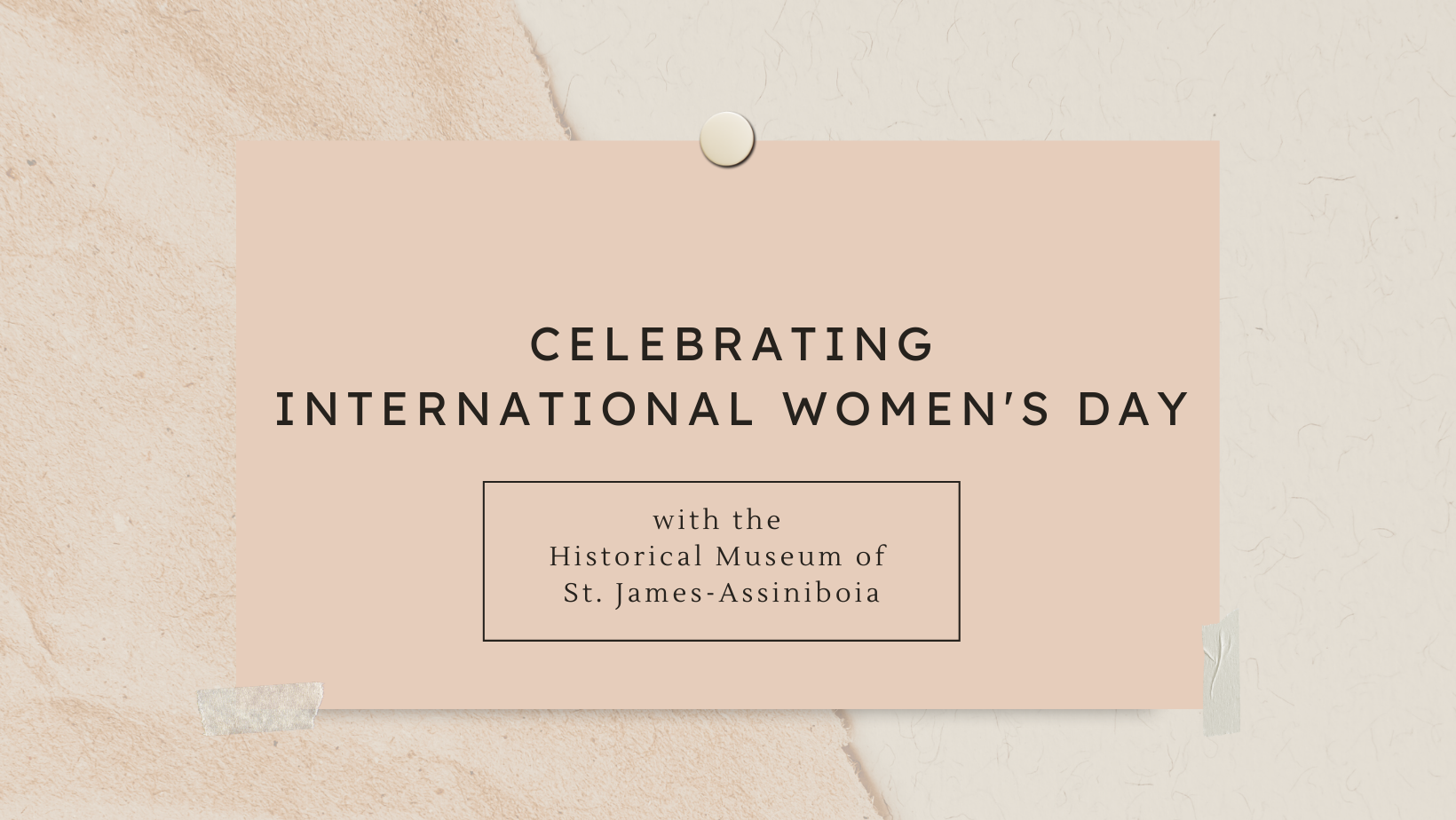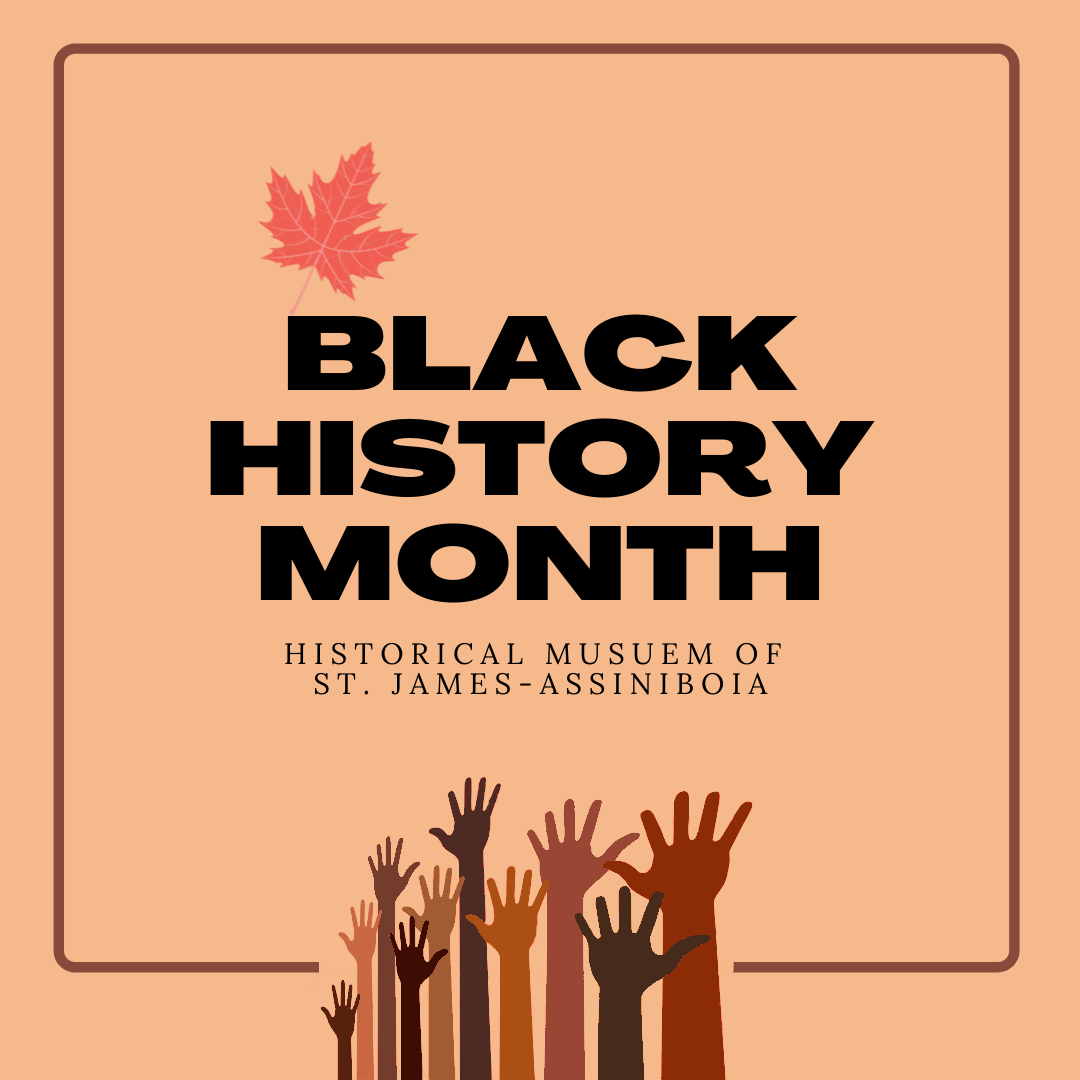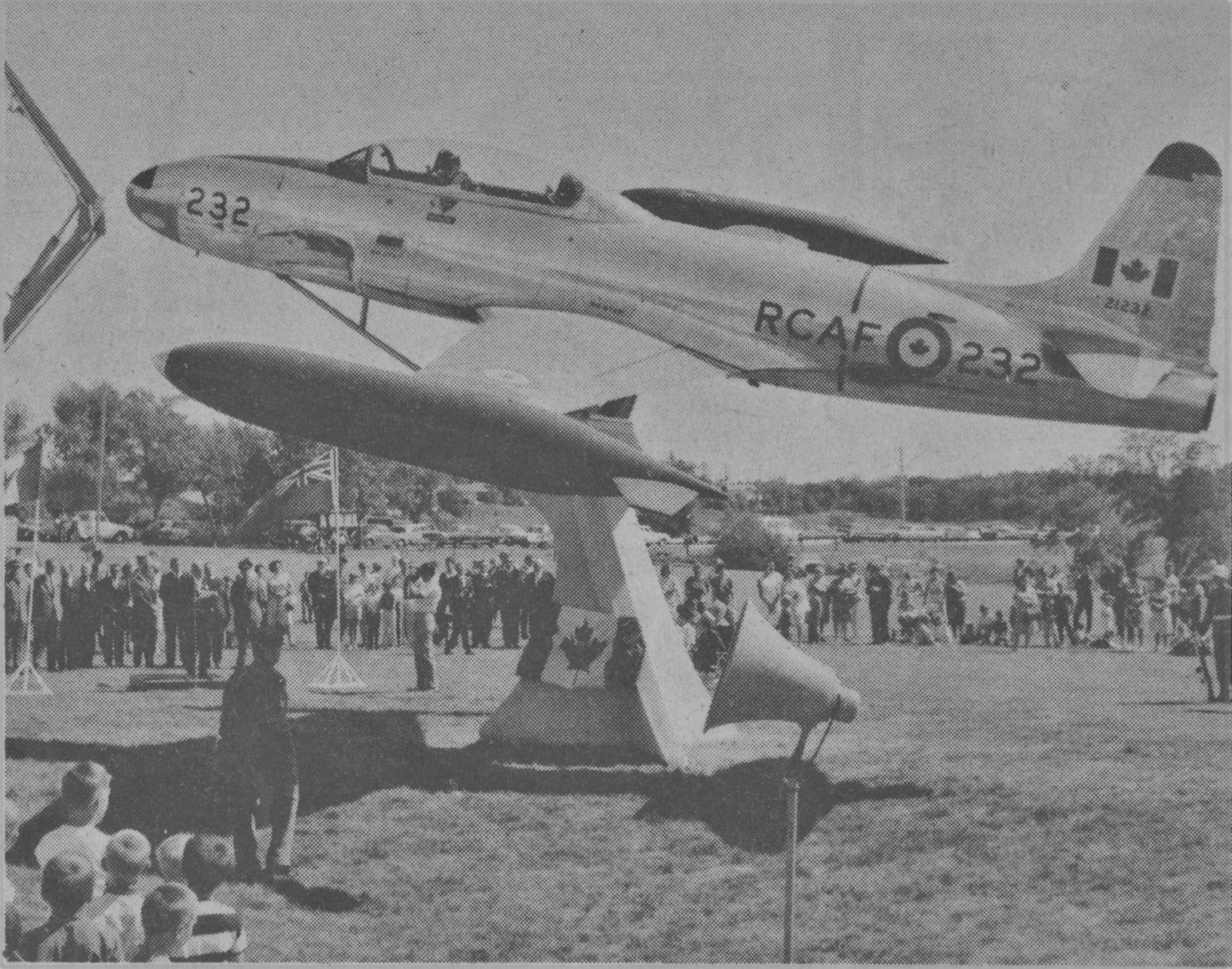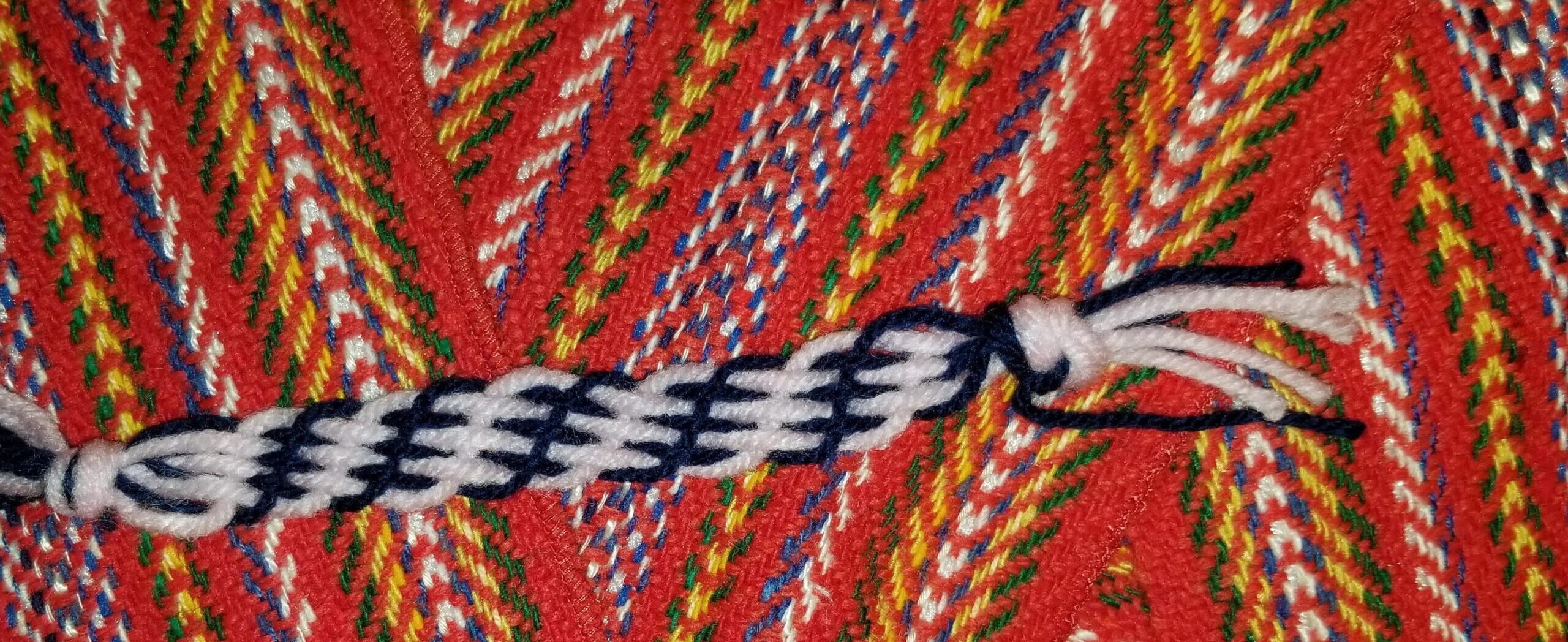Celebrations Day 2023










Beading Workshop will be held on June 25th at the Historical Museum of St. James-Assiniboia (3180 Portage Avenue). Space is limited. Registration in advance is required. Email sjamuseum@gmail.com to register. Beading Workshop is for adults and older youth only.
Teepee Craft is a kit that can be picked up from the Museum and completed at home. Crafts are $4 each and quantity is limited. Please email sjamuseum@gmail.com before coming in to reserve your kits for pickup. Pickup is available June 21-24 from 2:30pm to 4pm and June 25 from 10am to 4pm.



Today we celebrate International Women’s Day by sharing the stories of women throughout history from right here in Manitoba.
Celebrating Indigenous Women through Storytelling, Music, and Dance
Indigenous culture and history has been passed down through oral storytelling, music, and dance. Barbara Nepinak and her husband Clarence, Order of Manitoba recipients and Museum Cultural Facilitators, have shared their culture with us throughout the years. Today, we celebrate all the Indigenous women sharing their culture with the next generation. Please join Barbara and Clarence Nepinak as they share stories of Indigenous Women and Peoples with us through storytelling, music, and dance.
Charlotte Taylor
Charlotte Taylor, daughter of John Taylor and granddaughter of Métis woman Charlotte Omand and Scottish immigrant William Brown, is the star of the Museum’s award-winning historical theatre. Join Charlotte as she introduces herself and tells us a bit about her life in the 1890s.
Lady Strathcona
Join our Executive Director and Curator as she walks you through our latest exhibit featuring a prominent women from our history, Lady Strathcona.
Annie Godkin
Annie Godkin was the wife of Joseph Godkin, the first Reeve of St. James in 1921. Join us here to learn about the beginnings of St. James and then hear from Annie Godkin.
Kathleen Livingstone

An actress, activist, and radio broadcaster, Kathleen ‘Kay’ Livingstone was a woman of many talents. She was known as one of Canada’s leading Black actresses in her lifetime, and had a career as the radio show host of her show ‘The Kathleen Livingstone Show.’
But Livingstone is probably best known for her passion for social activism, especially concerning the welfare of Black women. She joined several organizations that worked to promote the pride and advancement of Black communities. She was the organizer and chair of the National Congress of Black Women in Canada, the first meeting taking place in 1973. The Congress provided a platform for Black women to share their concerns and facilitate causes they believed in. Because of its outstanding success, the Congress began to hold further conventions in different provinces.
It was at the Winnipeg convention in 1980 that the Congress of Black Women was established as a national forum and foundation, and the organization remains today as one of Livingstone’s lasting legacies.
Livingstone also worked for the Privy Council of Canada as a consultant in the later years of her life. Her work for activism did not halt though, and in 1975 Livingstone began organizing a conference on visible minorities–a term whose origin she is credited with –in Canada. She had been travelling the country in preparation for it beforehand. However, Livingstone died in the same year.
Carrie Best, who had met with Livingstone on her travels, formed the Kay Livingstone Visible Minority Women’s Society in her honour after her death.

This February, join us in celebrating Black History Month by learning about prominent Black figures in Manitoba and across Canada.

Percy Haynes
One iconic member of the Winnipeg music scene for much of his life was star athlete and talented pianist Piercy Augustus “Percy” Haynes. He was–and is–best known for his famed and well-loved restaurant Haynes Chicken Shack, located on 257 Lulu Street. The restaurant was a hotspot for local musicians, and even attracted the attention of internationally acclaimed singers.
But before Haynes opened up the restaurant with his wife Zena, he had already made a name for himself as a rising young athlete. His name was featured in the newspapers for several championships he won playing basketball and practicing amateur boxing.
Haynes was also the first modern Black Canadian to be enlisted in the Royal Canadian Navy, He joined in the wake of WWII, an accomplishment achieved by campaining to military officials to remove the discriminatory law. It was after the war that Haynes opened up his restaurant, and it remained the source of much of his time and passion until his death in 1992.

William Beal
One of the first Black American settlers in Manitoba was a man named William Sylvester ‘Billy’ Beal. In the year 1906, Beal migrated to Manitoba in hopes of a job prospect and new opportunities, settling down in Swan River Valley with a homestead granted to him in the Big Woody district. Originally hailing from Chelsea, Massachusetts, Beal grew up in Minneapolis and received his secondary education from there. His experience as a steam engineer allowed his arrival in Swan River Valley to be immediately met with the prospect of working at a saw mill within the locality.
What is most remarkable about Beal is the vast array of contributions he made to his community within the short time of his migration. He shared his love of reading by building the region’s first circulating library, and also founded a literary society and debating club. Education was another keen interest of his, and he was elected as treasurer to the Big Woody district’s Board of School Trustees. He served on it for over thirty years.
But William Beal is perhaps best known for his passion for photography. Despite being self-taught, Beal’s talent shone in his work, a product of the wealth of time he spent documenting the local people and life on the rural prairies. His subjects ranged from his neighbours to the log camps of his work.
After his retirement, Beal moved to The Pas in 1955. He died there and was buried in the town cemetery. But Beal’s contributions and impact on Swan River Valley in its formative years have begun to be recognized and preserved, a much deserved celebration to the accomplishments of one of Manitoba’s first Black pioneers.

George Hutchinson Beckford
The life of train porters in Canada was not an easy one in the 1800’s. It was a job wrought with arduous labour and long, grueling hours that left little time for rest, much less a full night of sleep. The intensive hours meant porters were separated from their family for long periods of time, often stretching to weeks and months without ever seeing them. But a job on the railway as a porter was one reserved for Black men, as it was nearly impossible to find employment elsewhere due to racist laws and segregation policies.
George Hutchinson Beckford, a Black Jamaican-Canadian who arrived in Winnipeg in 1913, was determined to find a different career than the above precedent. On his arrival to the city he worked as a railway porter for only a year before he left to begin working independently as a taxi driver and chauffeur. But this only lasted for four years, as he was drafted into the army in 1917.
When the First World War finally came to a close, Beckford returned to Winnipeg and took up work as a train porter. He left his job in 1926 to start up a cafe business, but it proved fruitful for only a few years, and he resumed work as a train porter yet again with the Canadian National Railway.
Beckford’s return would signify the beginning of his life-long career as a unionist and labour activist. He joined the Order of Sleeping Car Porters (OSCP) and was elected as representative and chairman of the union. In 1947, Beckford was elected as treasurer of the Winnipeg Labour Council. His talent for public speaking, passion for activism and education reform made Beckford an extremely popular labour figure from the 1940’s to 50’s. He gave speeches urging for improved vocational training at the secondary level of schooling, which earned him a spot on the Winnipeg School Division’s advisory committee.
In 1954, George Beckford retired from his position on the Winnipeg Labour Council and his career at the CNR and OSCP. He later died at the age of 86 in 1976. Beckford’s work as an activist for labour rights on the railway was crucial to kickstarting the much needed reformation of the job of Black train porters, and its impact was felt long after his death.

Kathleen Livingstone
An actress, activist, and radio broadcaster, Kathleen ‘Kay’ Livingstone was a woman of many talents. She was known as one of Canada’s leading Black actresses in her lifetime, and had a career as the radio show host of her show ‘The Kathleen Livingstone Show.’
But Livingstone is probably best known for her passion for social activism, especially concerning the welfare of Black women. She joined several organizations that worked to promote the pride and advancement of Black communities. She was the organizer and chair of the National Congress of Black Women in Canada, the first meeting taking place in 1973. The Congress provided a platform for Black women to share their concerns and facilitate causes they believed in. Because of its outstanding success, the Congress began to hold further conventions in different provinces.
It was at the Winnipeg convention in 1980 that the Congress of Black Women was established as a national forum and foundation, and the organization remains today as one of Livingstone’s lasting legacies.
Livingstone also worked for the Privy Council of Canada as a consultant in the later years of her life. Her work for activism did not halt though, and in 1975 Livingstone began organizing a conference on visible minorities–a term whose origin she is credited with –in Canada. She had been travelling the country in preparation for it beforehand. However, Livingstone died in the same year.
Carrie Best, who had met with Livingstone on her travels, formed the Kay Livingstone Visible Minority Women’s Society in her honour after her death.

George Brooks
Eventful, remarkable, and persevering are just a few of the words that can be used to describe George Semperins (St. Pierre) Brooks life. Born in Cuba, Brooks and his mother were sold to slavemaster William Howard in Kentucky. While the American Civil War raged, Brooks worked on Howard’s farm until he was able to later escape. But his freedom did not last long, as he was captured by Union forces and allegedly became General Ulysses Grant’s servant.
When the Civil War came to a close, Brooks took on a number of jobs. He claimed to have sung for Queen Victoria by joining the Fisk Jubilee SIngers of Nashville, and also reportedly worked for P.T Barnum in 1873. But it was not much longer till Brooks found himself on the battlefield again. In 1898 he served for 6 months on the 8th Illinois Battalion during the Spanish-American war.
Brooks arrived in Manitoba in 1911, and took up farming before he signed as a cook for the 27th Battalion in Winnipeg during WWI. He gave his age as 40, but was hospitalized for syphilis and sent home once his real age of 70 was discovered. Brooks settled in Winnipeg for the remainder of his life, and he enjoyed regaling the tales of his life to anyone who would listen. His talent for story-telling was undeniable, and the Winnipeg Tribune held interviews with him that were later featured in the newspaper’s issues.
George Semperins Brooks died at Deer Lodge Hospital in 1948. He was buried in Brookside Cemetery at the age of 105, and was considered one of Canada’s oldest soldiers at the time.
Sources: Memorable Manitobans: George Semperins (St. Pierre) Brooks (1845-1948) (mhs.mb.ca)

Clay Lewis
An advocate for change and patron of several charitable organizations, Claydean ‘Clay’ Virgil Lewis has been described as a mentor and friend to many. Born in Memphis Tennessee, Lewis arrived in Winnipeg in 1948 and worked as a porter for the C.P.R. He left a year later to study at Morehouse University, finishing with a Bachelor of Arts in Administrations and Psychology. On his return to Winnipeg he resumed work as a porter again, but his time in the city was cut short by his draft into the U.S army in 1951. Lewis served in the Korean War with the Infantry Regiment as the Master Sergeant of the Heavy Tank Corps. Lauded for his heroism, Lewis received a Silver Star and returned to Winnipeg upon his discharge.
He worked with the C.P.R again for a short time before attending the University of Michigan. There he received his Bachelor of Social Work and his Master of Social Work degrees. Lewis returned to Winnipeg, and this time it seemed for good. He worked at the Rehab Hospital as the Supervisor of Social Services and became the first social worker employed by Meals on Wheels. He continued to work with multiple health organizations until he met John Rodgers in 1971.
The two became good friends and founded the well-loved ‘Main Street Project’’. Lewis worked as the organization’s assistant director and spent the next few decades tirelessly supporting Winnipeg’s inner city. He also founded and served on several other social organizations and projects dedicated to the marginalized.
Lewis retired from his position on the Main Street Project in 2002. It was at that time that he also received the Queen Elizabeth II Golden Jubilee Medal in recognition of his community service. Lewis passed away on January 21st, 2018, but the work he has done for Winnipeg’s community has continued to positively impact those who need it most, even after his death.
Sources: http://www.mhs.mb.ca/docs/people/lewis_cv.shtml


Register for the contest by emailing st.jamesassiniboiamuseum@gmail.com with your name, address and phone number.
Each home will be judged in the following three categories:
Creativity, Innovation, and Overall Presentation.
Let’s light up Westwood and spread some cheer this Holiday Season!

In celebration of the centennial of St. James, the Historical Museum of St. James-Assiniboia presents A Century of Modern Sound with Jason Eastwood. Throughout the years 1921-2021, many entertainers created music that resonated deeply with the citizens living in St. James-Assiniboia and helped shaped their lives.
Classical guitarist and composer, Jason Eastwood, discusses some of the entertainers and songwriters that have had an impact on the citizens living in St. James-Assiniboia over the last one hundred years. Jason will also be performing examples of their work on the guitar. These entertainers might have written, produced and arranged their songs in a variety of different ways, from rock, to country, to jazz. However, Jason will be preforming his original songs in a “Troubadour style/Singer-songwriter” style.
This series will end with a song-writing workshop, where Jason walks youth, and people of all ages, through the process of writing music to inspire the next century of great music.
This multipart series consists of pre-recorded videos that will be available to watch throughout the entire duration of Culture Days. Starting September 24, 2021 watch the entire series right here or follow us on Facebook at the Historical Museum of St. James-Assiniboia for weekly installments.
This event is hosted by The Historical Museum of St. James-Assiniboia in participation with Culture Days Manitoba.


Throughout 2021, the Historical Museum of St. James-Assiniboia is celebrating 100 years of the Municipality of St. James, established in 1921.
Explore this page for educational and entertaining content that teaches about St. James in 1921 and throughout the years of its development.
Explore additional St. James Centennial content with the links below:
St. James Then and Now Photographs
Virtual Tour of Rudolph’s Beauty Parlour
Heritage Day 2021: Celebrating 100 Years of St. James
Learn about the beginnings of St. James and the formation of the Municipality of St. James in 1921 and then hear from Annie Godkin, wife of Joseph William Godkin the first Reeve of St. James.
Discover the rich history of aviation in St. James.
Learn about pharmacies in St. James throughout the 1900s and how they impacted the community.

This year we celebrate 100 Years of the Municipality of St. James established in 1921. The first council meeting of the newly established Municipality was held in the Museum’s 1911 Municipal Hall of Assiniboia. Although recently separated from Assiniboia, the St. James Municipality met here before having their own offices.

The armchair pictured here was presented to George T. Chapman on his retiring as Reeve of the Rural Municipality of Assiniboia in 1912. The chair, which still sits inside the Museum’s 1911 Municipal Hall, would have been present in the Municipal Hall during the first meeting of the Municipality of St. James.
In the years following World War II the Municipality of St. James completely surpassed the Municipality of Assiniboia. Nearly 2500 new homes were built between 1948 and 1955. St. James was the fastest growing municipality in the greater Winnipeg area, and it soon had all the attributes of a city.

In April 1956, St. James with a population of 26,870 received its City Charter from the province. A huge parade marked the occasion. Speeches, a band concert, a sing a long and fireworks at Bruce Park.

In 1969, after a 49-year separation, St. James and Assiniboia were reunited as the City of St. James-Assiniboia.
Assiniboia had attracted little industry and its tax base was almost entirely residential. The amalgamation of St. James and Assiniboia took effect on January 1st. The new City of St. James-Assiniboia, Manitoba’s second largest with a population of 67,000, occupied 28,048 acres.
In 1960 a government body known as “Metro”, the Metropolitan Corporation of Greater Winnipeg, was established to perform local services for all Greater Winnipeg Municipalities.

In June 1968, Metro Council declared itself in favour of one government for Greater Winnipeg. Known as Central City, or Unicity, the incorporation of all twelve than existing municipalities and cities into a single city/urban government took effect on January 1, 1972. At the time. St. James-Assiniboia was the largest and most prosperous of the Greater Winnipeg cities and municipalities.
Read more about the history of St. James-Assiniboia here.

Join us at the Historical Museum of St. James-Assiniboia for music, crafts, and information on the COVID-19 vaccine. We believe in supporting our community, which means ensuring that everyone has reliable information on the COVID-19 vaccine. With the support of Protect MB we are helping to connect you with the information you need on the COVID-19 vaccine.
Each virtual session will consist of an interactive music workshop or a craft demonstration, and information on the COVID-19 vaccine from Protect MB and information on where you can find further reliable resources on the vaccine.
Join us for short sessions consisting of a craft demonstration. Make your very own craft and learn about the COVID-19 vaccine. You can participate with materials from home or pick-up a free craft packet from the museum. Register for the live sessions by emailing st.jamesassiniboiamuseum@gmail.com or stay tuned to our Facebook page to watch the recorded video.
Live Teepee Craft Session on August 25, 2021 at 2pm
Watch the recording of Teepee Craft live session below:
Live Finger Weaving Session on August 27, 2021 at 2pm
Watch the recording of Finger Weaving live session below:
Recorded Keepsake Pouch Session premiering September 10, 2021
Watch the recording of Keepsake Pouch session below:
Join us for an interactive music workshop “Hey, Let’s Write Our Own Music!” led by guitarist and composer Jason Eastwood. What’s it like to write your own music? Jason Eastwood, a composer and songwriter himself, is going to show you how he writes his music so you can too. Jason will also perform a concert of his own music so you can get inspired to write your own. Come listen and learn about the COVID-19 vaccine.
Part 1: Improvisation -Where do ideas come from?
Watch the recording of the September 15, 2021 session below:
Part 2: Instrumentals -All you need is a melody and some chords, but what are those?
Watch the recording of the September 22, 2021 session below:
Part 3: Songs -Sing your heart out. What do you have to say to the world?
Watch the recording of the September 29, 2021 session below:
Learn how to book your vaccine appointment.
Find frequently asked questions about the COVID-19 vaccine.
Learn about vaccine myths and facts.

Join a live Virtual Finger Weaving Workshop with the Historical Museum of St. James-Assiniboia on August 27, 2021 at 2pm.
Register by emailing st.jamesassiniboiamuseum@gmail.com and let us know how many craft kits you require. You can also make this craft with supplies from home! You will need yarn in at least two different colours.
Pick up craft kits ahead of time at 3180 Portage Avenue.
Guidelines:
This workshop is made possible through funding from ProtectMB. Have questions about how the COVID-19 vaccines were made and how they work? Visit https://protectmb.ca/vax-facts/ for VAX Facts videos and more.